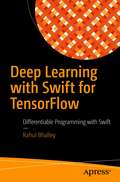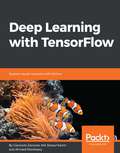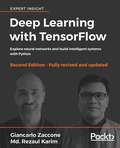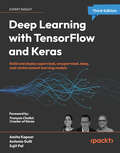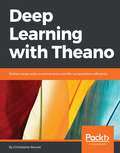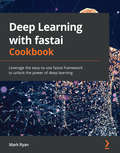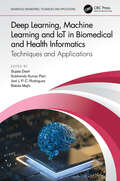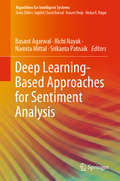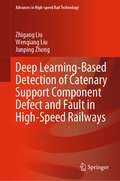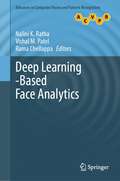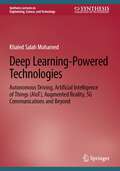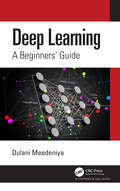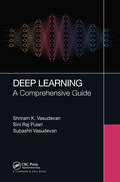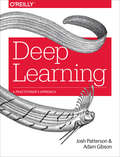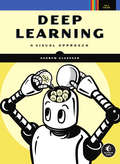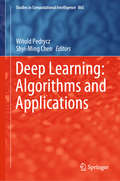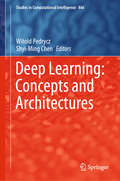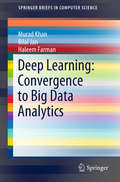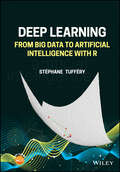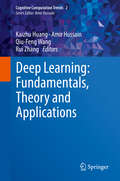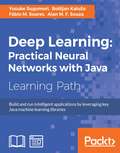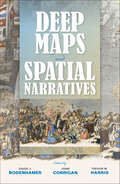- Table View
- List View
Deep Learning with Swift for TensorFlow: Differentiable Programming with Swift
by Rahul BhalleyDiscover more insight about deep learning algorithms with Swift for TensorFlow. The Swift language was designed by Apple for optimized performance and development whereas TensorFlow library was designed by Google for advanced machine learning research. Swift for TensorFlow is a combination of both with support for modern hardware accelerators and more. This book covers the deep learning concepts from fundamentals to advanced research. It also introduces the Swift language for beginners in programming. This book is well suited for newcomers and experts in programming and deep learning alike. After reading this book you should be able to program various state-of-the-art deep learning algorithms yourself. The book covers foundational concepts of machine learning. It also introduces the mathematics required to understand deep learning. Swift language is introduced such that it allows beginners and researchers to understand programming and easily transit to Swift for TensorFlow, respectively. You will understand the nuts and bolts of building and training neural networks, and build advanced algorithms. What You’ll Learn • Understand deep learning concepts • Program various deep learning algorithms • Run the algorithms in cloud Who This Book Is For • Newcomers to programming and/or deep learning, and experienced developers. • Experienced deep learning practitioners and researchers who desire to work in user space instead of library space with a same programming language without compromising the speed
Deep Learning with TensorFlow
by Giancarlo Zaccone Md. Rezaul Karim Ahmed MenshawyDelve into neural networks, implement deep learning algorithms, and explore layers of data abstraction with the help of this comprehensive TensorFlow guide About This Book • Learn how to implement advanced techniques in deep learning with Google's brainchild, TensorFlow • Explore deep neural networks and layers of data abstraction with the help of this comprehensive guide • Real-world contextualization through some deep learning problems concerning research and application Who This Book Is For The book is intended for a general audience of people interested in machine learning and machine intelligence. A rudimentary level of programming in one language is assumed, as is a basic familiarity with computer science techniques and technologies, including a basic awareness of computer hardware and algorithms. Some competence in mathematics is needed to the level of elementary linear algebra and calculus. What You Will Learn • Learn about machine learning landscapes along with the historical development and progress of deep learning • Learn about deep machine intelligence and GPU computing with the latest TensorFlow 1.x • Access public datasets and utilize them using TensorFlow to load, process, and transform data • Use TensorFlow on real-world datasets, including images, text, and more • Learn how to evaluate the performance of your deep learning models • Using deep learning for scalable object detection and mobile computing • Train machines quickly to learn from data by exploring reinforcement learning techniques • Explore active areas of deep learning research and applications In Detail Deep learning is the step that comes after machine learning, and has more advanced implementations. Machine learning is not just for academics anymore, but is becoming a mainstream practice through wide adoption, and deep learning has taken the front seat. As a data scientist, if you want to explore data abstraction layers, this book will be your guide. This book shows how this can be exploited in the real world with complex raw data using TensorFlow 1.x. Throughout the book, you'll learn how to implement deep learning algorithms for machine learning systems and integrate them into your product offerings, including search, image recognition, and language processing. Additionally, you'll learn how to analyze and improve the performance of deep learning models. This can be done by comparing algorithms against benchmarks, along with machine intelligence, to learn from the information and determine ideal behaviors within a specific context. After finishing the book, you will be familiar with machine learning techniques, in particular the use of TensorFlow for deep learning, and will be ready to apply your knowledge to research or commercial projects. Style and approach This step-by-step guide will explore common, and not so common, deep neural networks and show how these can be exploited in the real world with complex raw data. With the help of practical examples, you will learn how to implement different types of neural nets to build smart applications related to text, speech, and image data processing.
Deep Learning with TensorFlow - Second Edition: Explore Neural Networks And Build Intelligent Systems With Python, 2nd Edition
by Giancarlo Zaccone Rezaul Karim<P><P>Delve into neural networks, implement deep learning algorithms, and explore layers of data abstraction with the help of TensorFlow. <P><P>Key Features <P><P>Learn how to implement advanced techniques in deep learning with Google's brainchild, TensorFlow <P><P>Explore deep neural networks and layers of data abstraction with the help of this comprehensive guide <P><P>Gain real-world contextualization through some deep learning problems concerning research and application <P><P>Book Description <P><P>Deep learning is a branch of machine learning algorithms based on learning multiple levels of abstraction. Neural networks, which are at the core of deep learning, are being used in predictive analytics, computer vision, natural language processing, time series forecasting, and to perform a myriad of other complex tasks. <P><P>This book is conceived for developers, data analysts, machine learning practitioners and deep learning enthusiasts who want to build powerful, robust, and accurate predictive models with the power of TensorFlow, combined with other open source Python libraries. <P><P>Throughout the book, you'll learn how to develop deep learning applications for machine learning systems using Feedforward Neural Networks, Convolutional Neural Networks, Recurrent Neural Networks, Autoencoders, and Factorization Machines. Discover how to attain deep learning programming on GPU in a distributed way. <P><P>You'll come away with an in-depth knowledge of machine learning techniques and the skills to apply them to real-world projects. <P><P>What you will learn <P><P>Apply deep machine intelligence and GPU computing with TensorFlow <P><P>Access public datasets and use TensorFlow to load, process, and transform the data <P><P>Discover how to use the high-level TensorFlow API to build more powerful applications <P><P>Use deep learning for scalable object detection and mobile computing <P><P>Train machines quickly to learn from data by exploring reinforcement learning techniques <P><P>Explore active areas of deep learning research and applications <P><P>Who This Book Is For <P><P>The book is for people interested in machine learning and machine intelligence. A rudimentary level of programming in one language is assumed, as is a basic familiarity with computer science techniques and technologies, including a basic awareness of computer hardware and algorithms. Some competence in mathematics is needed to the level of elementary linear algebra and calculus.
Deep Learning with TensorFlow 2 and Keras: Regression, ConvNets, GANs, RNNs, NLP, and more with TensorFlow 2 and the Keras API, 2nd Edition
by Antonio Gulli Sujit Pal Amita KapoorBuild machine and deep learning systems with the newly released TensorFlow 2 and Keras for the lab, production, and mobile devices Key Features Introduces and then uses TensorFlow 2 and Keras right from the start Teaches key machine and deep learning techniques Understand the fundamentals of deep learning and machine learning through clear explanations and extensive code samples Book Description Deep Learning with TensorFlow 2 and Keras, Second Edition teaches neural networks and deep learning techniques alongside TensorFlow (TF) and Keras. You'll learn how to write deep learning applications in the most powerful, popular, and scalable machine learning stack available. TensorFlow is the machine learning library of choice for professional applications, while Keras offers a simple and powerful Python API for accessing TensorFlow. TensorFlow 2 provides full Keras integration, making advanced machine learning easier and more convenient than ever before. This book also introduces neural networks with TensorFlow, runs through the main applications (regression, ConvNets (CNNs), GANs, RNNs, NLP), covers two working example apps, and then dives into TF in production, TF mobile, and using TensorFlow with AutoML. What you will learn Build machine learning and deep learning systems with TensorFlow 2 and the Keras API Use Regression analysis, the most popular approach to machine learning Understand ConvNets (convolutional neural networks) and how they are essential for deep learning systems such as image classifiers Use GANs (generative adversarial networks) to create new data that fits with existing patterns Discover RNNs (recurrent neural networks) that can process sequences of input intelligently, using one part of a sequence to correctly interpret another Apply deep learning to natural human language and interpret natural language texts to produce an appropriate response Train your models on the cloud and put TF to work in real environments Explore how Google tools can automate simple ML workflows without the need for complex modeling Who this book is for This book is for Python developers and data scientists who want to build machine learning and deep learning systems with TensorFlow. Whether or not you have done machine learning before, this book gives you the theory and practice required to use Keras, TensorFlow 2, and AutoML to build machine learning systems.
Deep Learning with TensorFlow and Keras: Build and deploy supervised, unsupervised, deep, and reinforcement learning models, 3rd Edition
by Antonio Gulli Sujit Pal Amita Kapoor Francois CholletBuild cutting edge machine and deep learning systems for the lab, production, and mobile devicesKey FeaturesUnderstand the fundamentals of deep learning and machine learning through clear explanations and extensive code samplesImplement graph neural networks, transformers using Hugging Face and TensorFlow Hub, and joint and contrastive learningLearn cutting-edge machine and deep learning techniquesBook DescriptionDeep Learning with TensorFlow and Keras teaches you neural networks and deep learning techniques using TensorFlow (TF) and Keras. You'll learn how to write deep learning applications in the most powerful, popular, and scalable machine learning stack available.TensorFlow 2.x focuses on simplicity and ease of use, with updates like eager execution, intuitive higher-level APIs based on Keras, and flexible model building on any platform. This book uses the latest TF 2.0 features and libraries to present an overview of supervised and unsupervised machine learning models and provides a comprehensive analysis of deep learning and reinforcement learning models using practical examples for the cloud, mobile, and large production environments.This book also shows you how to create neural networks with TensorFlow, runs through popular algorithms (regression, convolutional neural networks (CNNs), transformers, generative adversarial networks (GANs), recurrent neural networks (RNNs), natural language processing (NLP), and graph neural networks (GNNs)), covers working example apps, and then dives into TF in production, TF mobile, and TensorFlow with AutoML.What you will learnLearn how to use the popular GNNs with TensorFlow to carry out graph mining tasksDiscover the world of transformers, from pretraining to fine-tuning to evaluating themApply self-supervised learning to natural language processing, computer vision, and audio signal processingCombine probabilistic and deep learning models using TensorFlow ProbabilityTrain your models on the cloud and put TF to work in real environmentsBuild machine learning and deep learning systems with TensorFlow 2.x and the Keras APIWho this book is forThis hands-on machine learning book is for Python developers and data scientists who want to build machine learning and deep learning systems with TensorFlow. This book gives you the theory and practice required to use Keras, TensorFlow, and AutoML to build machine learning systems.Some machine learning knowledge would be useful. We don't assume TF knowledge.
Deep Learning with TensorFlow: Explore neural networks and build intelligent systems with Python, 2nd Edition
by Giancarlo Zaccone Md. Rezaul KarimDelve into neural networks, implement deep learning algorithms, and explore layers of data abstraction with the help of TensorFlow v1.7.Key Features Learn how to implement advanced techniques in deep learning with Google's brainchild, TensorFlow v1.7 Explore deep neural networks and layers of data abstraction with the help of this comprehensive guide Gain real-world contextualization through some deep learning problems concerning research and applicationBook DescriptionDeep learning is a branch of machine learning algorithms based on learning multiple levels of abstraction. Neural networks, which are at the core of deep learning, are being used in predictive analytics, computer vision, natural language processing, time series forecasting, and to perform a myriad of other complex tasks.This book is conceived for developers, data analysts, machine learning practitioners and deep learning enthusiasts who want to build powerful, robust, and accurate predictive models with the power of TensorFlow v1.7, combined with other open source Python libraries. Throughout the book, you’ll learn how to develop deep learning applications for machine learning systems using Feedforward Neural Networks, Convolutional Neural Networks, Recurrent Neural Networks, Autoencoders, and Factorization Machines. Discover how to attain deep learning programming on GPU in a distributed way.You'll come away with an in-depth knowledge of machine learning techniques and the skills to apply them to real-world projects.What you will learn Apply deep machine intelligence and GPU computing with TensorFlow v1.7 Access public datasets and use TensorFlow to load, process, and transform the data Discover how to use the high-level TensorFlow API to build more powerful applications Use deep learning for scalable object detection and mobile computing Train machines quickly to learn from data by exploring reinforcement learning techniques Explore active areas of deep learning research and applicationsWho this book is forThe book is for people interested in machine learning and machine intelligence. A rudimentary level of programming in one language is assumed, as is a basic familiarity with computer science techniques and technologies, including a basic awareness of computer hardware and algorithms. Some competence in mathematics is needed to the level of elementary linear algebra and calculus.
Deep Learning with Theano
by Christopher BourezDevelop deep neural networks in Theano with practical code examples for image classification, machine translation, reinforcement agents, or generative models. About This Book • Learn Theano basics and evaluate your mathematical expressions faster and in an efficient manner • Learn the design patterns of deep neural architectures to build efficient and powerful networks on your datasets • Apply your knowledge to concrete fields such as image classification, object detection, chatbots, machine translation, reinforcement agents, or generative models. Who This Book Is For This book is indented to provide a full overview of deep learning. From the beginner in deep learning and artificial intelligence, to the data scientist who wants to become familiar with Theano and its supporting libraries, or have an extended understanding of deep neural nets. Some basic skills in Python programming and computer science will help, as well as skills in elementary algebra and calculus. What You Will Learn • Get familiar with Theano and deep learning • Provide examples in supervised, unsupervised, generative, or reinforcement learning. • Discover the main principles for designing efficient deep learning nets: convolutions, residual connections, and recurrent connections. • Use Theano on real-world computer vision datasets, such as for digit classification and image classification. • Extend the use of Theano to natural language processing tasks, for chatbots or machine translation • Cover artificial intelligence-driven strategies to enable a robot to solve games or learn from an environment • Generate synthetic data that looks real with generative modeling • Become familiar with Lasagne and Keras, two frameworks built on top of Theano In Detail This book offers a complete overview of Deep Learning with Theano, a Python-based library that makes optimizing numerical expressions and deep learning models easy on CPU or GPU. The book provides some practical code examples that help the beginner understand how easy it is to build complex neural networks, while more experimented data scientists will appreciate the reach of the book, addressing supervised and unsupervised learning, generative models, reinforcement learning in the fields of image recognition, natural language processing, or game strategy. The book also discusses image recognition tasks that range from simple digit recognition, image classification, object localization, image segmentation, to image captioning. Natural language processing examples include text generation, chatbots, machine translation, and question answering. The last example deals with generating random data that looks real and solving games such as in the Open-AI gym. At the end, this book sums up the best -performing nets for each task. While early research results were based on deep stacks of neural layers, in particular, convolutional layers, the book presents the principles that improved the efficiency of these architectures, in order to help the reader build new custom nets. Style and approach It is an easy-to-follow example book that teaches you how to perform fast, efficient computations in Python. Starting with the very basics-NumPy, installing Theano, this book will take you to the smooth journey of implementing Theano for advanced computations for machine learning and deep learning.
Deep Learning with fastai Cookbook: Leverage the easy-to-use fastai framework to unlock the power of deep learning
by Mark RyanHarness the power of the easy-to-use, high-performance fastai framework to rapidly create complete deep learning solutions with few lines of codeKey FeaturesDiscover how to apply state-of-the-art deep learning techniques to real-world problemsBuild and train neural networks using the power and flexibility of the fastai frameworkUse deep learning to tackle problems such as image classification and text classificationBook Descriptionfastai is an easy-to-use deep learning framework built on top of PyTorch that lets you rapidly create complete deep learning solutions with as few as 10 lines of code. Both predominant low-level deep learning frameworks, TensorFlow and PyTorch, require a lot of code, even for straightforward applications. In contrast, fastai handles the messy details for you and lets you focus on applying deep learning to actually solve problems.The book begins by summarizing the value of fastai and showing you how to create a simple 'hello world' deep learning application with fastai. You'll then learn how to use fastai for all four application areas that the framework explicitly supports: tabular data, text data (NLP), recommender systems, and vision data. As you advance, you'll work through a series of practical examples that illustrate how to create real-world applications of each type. Next, you'll learn how to deploy fastai models, including creating a simple web application that predicts what object is depicted in an image. The book wraps up with an overview of the advanced features of fastai.By the end of this fastai book, you'll be able to create your own deep learning applications using fastai. You'll also have learned how to use fastai to prepare raw datasets, explore datasets, train deep learning models, and deploy trained models.What you will learnPrepare real-world raw datasets to train fastai deep learning modelsTrain fastai deep learning models using text and tabular dataCreate recommender systems with fastaiFind out how to assess whether fastai is a good fit for a given problemDeploy fastai deep learning models in web applicationsTrain fastai deep learning models for image classificationWho this book is forThis book is for data scientists, machine learning developers, and deep learning enthusiasts looking to explore the fastai framework using a recipe-based approach. Working knowledge of the Python programming language and machine learning basics is strongly recommended to get the most out of this deep learning book.
Deep Learning, Machine Learning and IoT in Biomedical and Health Informatics: Techniques and Applications (Biomedical Engineering)
by Sujata Dash Joel J. P. C. Rodrigues Subhendu Kumar Pani Babita MajhiBiomedical and Health Informatics is an important field that brings tremendous opportunities and helps address challenges due to an abundance of available biomedical data. This book examines and demonstrates state-of-the-art approaches for IoT and Machine Learning based biomedical and health related applications. This book aims to provide computational methods for accumulating, updating and changing knowledge in intelligent systems and particularly learning mechanisms that help us to induce knowledge from the data. It is helpful in cases where direct algorithmic solutions are unavailable, there is lack of formal models, or the knowledge about the application domain is inadequately defined. In the future IoT has the impending capability to change the way we work and live. These computing methods also play a significant role in design and optimization in diverse engineering disciplines. With the influence and the development of the IoT concept, the need for AI (artificial intelligence) techniques has become more significant than ever. The aim of these techniques is to accept imprecision, uncertainties and approximations to get a rapid solution. However, recent advancements in representation of intelligent IoTsystems generate a more intelligent and robust system providing a human interpretable, low-cost, and approximate solution. Intelligent IoT systems have demonstrated great performance to a variety of areas including big data analytics, time series, biomedical and health informatics. This book will be very beneficial for the new researchers and practitioners working in the biomedical and healthcare fields to quickly know the best performing methods. It will also be suitable for a wide range of readers who may not be scientists but who are also interested in the practice of such areas as medical image retrieval, brain image segmentation, among others. • Discusses deep learning, IoT, machine learning, and biomedical data analysis with broad coverage of basic scientific applications • Presents deep learning and the tremendous improvement in accuracy, robustness, and cross- language generalizability it has over conventional approaches • Discusses various techniques of IoT systems for healthcare data analytics • Provides state-of-the-art methods of deep learning, machine learning and IoT in biomedical and health informatics • Focuses more on the application of algorithms in various real life biomedical and engineering problems
Deep Learning-Based Approaches for Sentiment Analysis (Algorithms for Intelligent Systems)
by Basant Agarwal Namita Mittal Srikanta Patnaik Richi NayakThis book covers deep-learning-based approaches for sentiment analysis, a relatively new, but fast-growing research area, which has significantly changed in the past few years. The book presents a collection of state-of-the-art approaches, focusing on the best-performing, cutting-edge solutions for the most common and difficult challenges faced in sentiment analysis research. Providing detailed explanations of the methodologies, the book is a valuable resource for researchers as well as newcomers to the field.
Deep Learning-Based Detection of Catenary Support Component Defect and Fault in High-Speed Railways (Advances in High-speed Rail Technology)
by Zhigang Liu Wenqiang Liu Junping ZhongThis book focuses on the deep learning technologies and their applications in the catenary detection of high-speed railways. As the only source of power for high-speed trains, the catenary's service performance directly affects the safe operation of high-speed railways. This book systematically shows the latest research results of catenary detection in high-speed railways, especially the detection of catenary support component defect and fault. Some methods or algorithms have been adopted in practical engineering. These methods or algorithms provide important references and help the researcher, scholar, and engineer on pantograph and catenary technology in high-speed railways. Unlike traditional detection methods of catenary support component based on image processing, some advanced methods in the deep learning field, including convolutional neural network, reinforcement learning, generative adversarial network, etc., are adopted and improved in this book. The main contents include the overview of catenary detection of electrified railways, the introduction of some advance of deep learning theories, catenary support components and their characteristics in high-speed railways, the image reprocessing of catenary support components, the positioning of catenary support components, the detection of defect and fault, the detection based on 3D point cloud, etc.
Deep Learning-Based Face Analytics (Advances in Computer Vision and Pattern Recognition)
by Vishal M. Patel Rama Chellappa Nalini K. RathaThis book provides an overview of different deep learning-based methods for face recognition and related problems. Specifically, the authors present methods based on autoencoders, restricted Boltzmann machines, and deep convolutional neural networks for face detection, localization, tracking, recognition, etc. The authors also discuss merits and drawbacks of available approaches and identifies promising avenues of research in this rapidly evolving field. Even though there have been a number of different approaches proposed in the literature for face recognition based on deep learning methods, there is not a single book available in the literature that gives a complete overview of these methods. The proposed book captures the state of the art in face recognition using various deep learning methods, and it covers a variety of different topics related to face recognition. This book is aimed at graduate students studying electrical engineering and/or computer science. Biometrics is a course that is widely offered at both undergraduate and graduate levels at many institutions around the world: This book can be used as a textbook for teaching topics related to face recognition. In addition, the work is beneficial to practitioners in industry who are working on biometrics-related problems. The prerequisites for optimal use are the basic knowledge of pattern recognition, machine learning, probability theory, and linear algebra.
Deep Learning-Powered Technologies: Autonomous Driving, Artificial Intelligence of Things (AIoT), Augmented Reality, 5G Communications and Beyond (Synthesis Lectures on Engineering, Science, and Technology)
by Khaled Salah MohamedThis book covers various, leading-edge deep learning technologies. The author discusses new applications of deep learning and gives insight into the integration of deep learning with various application domains, such as autonomous driving, augmented reality, AIOT, 5G and beyond.
Deep Learning: A Beginners' Guide
by Dulani MeedeniyaThis book focuses on deep learning (DL), which is an important aspect of data science, that includes predictive modeling. DL applications are widely used in domains such as finance, transport, healthcare, automanufacturing, and advertising. The design of the DL models based on artificial neural networks is influenced by the structure and operation of the brain. This book presents a comprehensive resource for those who seek a solid grasp of the techniques in DL. Key features: • Provides knowledge on theory and design of state-of-the-art deep learning models for real-world applications. • Explains the concepts and terminology in problem-solving with deep learning. • Explores the theoretical basis for major algorithms and approaches in deep learning. • Discusses the enhancement techniques of deep learning models. • Identifies the performance evaluation techniques for deep learning models. Accordingly, the book covers the entire process flow of deep learning by providing awareness of each of the widely used models. This book can be used as a beginners’ guide where the user can understand the associated concepts and techniques. This book will be a useful resource for undergraduate and postgraduate students, engineers, and researchers, who are starting to learn the subject of deep learning.
Deep Learning: A Comprehensive Guide
by Shriram K Vasudevan Sini Raj Pulari Subashri VasudevanDeep Learning: A Comprehensive Guide provides comprehensive coverage of Deep Learning (DL) and Machine Learning (ML) concepts. DL and ML are the most sought-after domains, requiring a deep understanding – and this book gives no less than that. This book enables the reader to build innovative and useful applications based on ML and DL. Starting with the basics of neural networks, and continuing through the architecture of various types of CNNs, RNNs, LSTM, and more till the end of the book, each and every topic is given the utmost care and shaped professionally and comprehensively. Key Features Includes the smooth transition from ML concepts to DL concepts Line-by-line explanations have been provided for all the coding-based examples Includes a lot of real-time examples and interview questions that will prepare the reader to take up a job in ML/DL right away Even a person with a non-computer-science background can benefit from this book by following the theory, examples, case studies, and code snippets Every chapter starts with the objective and ends with a set of quiz questions to test the reader’s understanding Includes references to the related YouTube videos that provide additional guidance AI is a domain for everyone. This book is targeted toward everyone irrespective of their field of specialization. Graduates and researchers in deep learning will find this book useful.
Deep Learning: A Practical Introduction
by Manel Martinez-Ramon Meenu Ajith Aswathy Rajendra KurupAn engaging and accessible introduction to deep learning perfect for students and professionals In Deep Learning: A Practical Introduction, a team of distinguished researchers delivers a book complete with coverage of the theoretical and practical elements of deep learning. The book includes extensive examples, end-of-chapter exercises, homework, exam material, and a GitHub repository containing code and data for all provided examples. Combining contemporary deep learning theory with state-of-the-art tools, the chapters are structured to maximize accessibility for both beginning and intermediate students. The authors have included coverage of TensorFlow, Keras, and Pytorch. Readers will also find: Thorough introductions to deep learning and deep learning toolsComprehensive explorations of convolutional neural networks, including discussions of their elements, operation, training, and architecturesPractical discussions of recurrent neural networks and non-supervised approaches to deep learningFulsome treatments of generative adversarial networks as well as deep Bayesian neural networks Perfect for undergraduate and graduate students studying computer vision, computer science, artificial intelligence, and neural networks, Deep Learning: A Practical Introduction will also benefit practitioners and researchers in the fields of deep learning and machine learning in general.
Deep Learning: A Practitioner's Approach
by Adam Gibson Josh PattersonAlthough interest in machine learning has reached a high point, lofty expectations often scuttle projects before they get very far. How can machine learning—especially deep neural networks—make a real difference in your organization? This hands-on guide not only provides the most practical information available on the subject, but also helps you get started building efficient deep learning networks.Authors Adam Gibson and Josh Patterson provide theory on deep learning before introducing their open-source Deeplearning4j (DL4J) library for developing production-class workflows. Through real-world examples, you’ll learn methods and strategies for training deep network architectures and running deep learning workflows on Spark and Hadoop with DL4J.Dive into machine learning concepts in general, as well as deep learning in particularUnderstand how deep networks evolved from neural network fundamentalsExplore the major deep network architectures, including Convolutional and RecurrentLearn how to map specific deep networks to the right problemWalk through the fundamentals of tuning general neural networks and specific deep network architecturesUse vectorization techniques for different data types with DataVec, DL4J’s workflow toolLearn how to use DL4J natively on Spark and Hadoop
Deep Learning: A Visual Approach
by Andrew GlassnerA richly-illustrated, full-color introduction to deep learning that offers visual and conceptual explanations instead of equations. You'll learn how to use key deep learning algorithms without the need for complex math.Ever since computers began beating us at chess, they've been getting better at a wide range of human activities, from writing songs and generating news articles to helping doctors provide healthcare.Deep learning is the source of many of these breakthroughs, and its remarkable ability to find patterns hiding in data has made it the fastest growing field in artificial intelligence (AI). Digital assistants on our phones use deep learning to understand and respond intelligently to voice commands; automotive systems use it to safely navigate road hazards; online platforms use it to deliver personalized suggestions for movies and books - the possibilities are endless.Deep Learning: A Visual Approach is for anyone who wants to understand this fascinating field in depth, but without any of the advanced math and programming usually required to grasp its internals. If you want to know how these tools work, and use them yourself, the answers are all within these pages. And, if you're ready to write your own programs, there are also plenty of supplemental Python notebooks in the accompanying Github repository to get you going.The book's conversational style, extensive color illustrations, illuminating analogies, and real-world examples expertly explain the key concepts in deep learning, including: • How text generators create novel stories and articles • How deep learning systems learn to play and win at human games • How image classification systems identify objects or people in a photo • How to think about probabilities in a way that's useful to everyday life • How to use the machine learning techniques that form the core of modern AIIntellectual adventurers of all kinds can use the powerful ideas covered in Deep Learning: A Visual Approach to build intelligent systems that help us better understand the world and everyone who lives in it. It's the future of AI, and this book allows you to fully envision it. Full Color Illustrations
Deep Learning: Algorithms and Applications (Studies in Computational Intelligence #865)
by Witold Pedrycz Shyi-Ming ChenThis book presents a wealth of deep-learning algorithms and demonstrates their design process. It also highlights the need for a prudent alignment with the essential characteristics of the nature of learning encountered in the practical problems being tackled. Intended for readers interested in acquiring practical knowledge of analysis, design, and deployment of deep learning solutions to real-world problems, it covers a wide range of the paradigm’s algorithms and their applications in diverse areas including imaging, seismic tomography, smart grids, surveillance and security, and health care, among others. Featuring systematic and comprehensive discussions on the development processes, their evaluation, and relevance, the book offers insights into fundamental design strategies for algorithms of deep learning.
Deep Learning: Concepts and Architectures (Studies in Computational Intelligence #866)
by Witold Pedrycz Shyi-Ming ChenThis book introduces readers to the fundamental concepts of deep learning and offers practical insights into how this learning paradigm supports automatic mechanisms of structural knowledge representation. It discusses a number of multilayer architectures giving rise to tangible and functionally meaningful pieces of knowledge, and shows how the structural developments have become essential to the successful delivery of competitive practical solutions to real-world problems. The book also demonstrates how the architectural developments, which arise in the setting of deep learning, support detailed learning and refinements to the system design. Featuring detailed descriptions of the current trends in the design and analysis of deep learning topologies, the book offers practical guidelines and presents competitive solutions to various areas of language modeling, graph representation, and forecasting.
Deep Learning: Convergence to Big Data Analytics (SpringerBriefs in Computer Science)
by Murad Khan Bilal Jan Haleem FarmanThis book presents deep learning techniques, concepts, and algorithms to classify and analyze big data. Further, it offers an introductory level understanding of the new programming languages and tools used to analyze big data in real-time, such as Hadoop, SPARK, and GRAPHX. Big data analytics using traditional techniques face various challenges, such as fast, accurate and efficient processing of big data in real-time. In addition, the Internet of Things is progressively increasing in various fields, like smart cities, smart homes, and e-health. As the enormous number of connected devices generate huge amounts of data every day, we need sophisticated algorithms to deal, organize, and classify this data in less processing time and space. Similarly, existing techniques and algorithms for deep learning in big data field have several advantages thanks to the two main branches of the deep learning, i.e. convolution and deep belief networks. This book offers insights into these techniques and applications based on these two types of deep learning.
Deep Learning: From Big Data to Artificial Intelligence with R
by Stephane TufferyDEEP LEARNING A concise and practical exploration of key topics and applications in data science In Deep Learning: From Big Data to Artificial Intelligence with R, expert researcher Dr. Stéphane Tufféry delivers an insightful discussion of the applications of deep learning and big data that focuses on practical instructions on various software tools and deep learning methods relying on three major libraries: MXNet, PyTorch, and Keras-TensorFlow. In the book, numerous, up-to-date examples are combined with key topics relevant to modern data scientists, including processing optimization, neural network applications, natural language processing, and image recognition. This is a thoroughly revised and updated edition of a book originally released in French, with new examples and methods included throughout. Classroom-tested and intuitively organized, Deep Learning: From Big Data to Artificial Intelligence with R offers complimentary access to a companion website that provides R and Python source code for the examples offered in the book. Readers will also find: A thorough introduction to practical deep learning techniques with explanations and examples for various programming libraries Comprehensive explorations of a variety of applications for deep learning, including image recognition and natural language processing Discussions of the theory of deep learning, neural networks, and artificial intelligence linked to concrete techniques and strategies commonly used to solve real-world problems Perfect for graduate students studying data science, big data, deep learning, and artificial intelligence, Deep Learning: From Big Data to Artificial Intelligence with R will also earn a place in the libraries of data science researchers and practicing data scientists.
Deep Learning: Fundamentals, Theory and Applications (Cognitive Computation Trends #2)
by Amir Hussain Rui Zhang Kaizhu Huang Qiu-Feng WangThe purpose of this edited volume is to provide a comprehensive overview on the fundamentals of deep learning, introduce the widely-used learning architectures and algorithms, present its latest theoretical progress, discuss the most popular deep learning platforms and data sets, and describe how many deep learning methodologies have brought great breakthroughs in various applications of text, image, video, speech and audio processing. Deep learning (DL) has been widely considered as the next generation of machine learning methodology. DL attracts much attention and also achieves great success in pattern recognition, computer vision, data mining, and knowledge discovery due to its great capability in learning high-level abstract features from vast amount of data. This new book will not only attempt to provide a general roadmap or guidance to the current deep learning methodologies, but also present the challenges and envision new perspectives which may lead to further breakthroughs in this field. This book will serve as a useful reference for senior (undergraduate or graduate) students in computer science, statistics, electrical engineering, as well as others interested in studying or exploring the potential of exploiting deep learning algorithms. It will also be of special interest to researchers in the area of AI, pattern recognition, machine learning and related areas, alongside engineers interested in applying deep learning models in existing or new practical applications.
Deep Learning: Practical Neural Networks with Java
by Bostjan Kaluza Fabio M. Soares Yusuke Sugomori Alan M. SouzaBuild and run intelligent applications by leveraging key Java machine learning libraries About This Book • Develop a sound strategy to solve predictive modelling problems using the most popular machine learning Java libraries. • Explore a broad variety of data processing, machine learning, and natural language processing through diagrams, source code, and real-world applications • This step-by-step guide will help you solve real-world problems and links neural network theory to their application Who This Book Is For This course is intended for data scientists and Java developers who want to dive into the exciting world of deep learning. It will get you up and running quickly and provide you with the skills you need to successfully create, customize, and deploy machine learning applications in real life. What You Will Learn • Get a practical deep dive into machine learning and deep learning algorithms • Explore neural networks using some of the most popular Deep Learning frameworks • Dive into Deep Belief Nets and Stacked Denoising Autoencoders algorithms • Apply machine learning to fraud, anomaly, and outlier detection • Experiment with deep learning concepts, algorithms, and the toolbox for deep learning • Select and split data sets into training, test, and validation, and explore validation strategies • Apply the code generated in practical examples, including weather forecasting and pattern recognition In Detail Machine learning applications are everywhere, from self-driving cars, spam detection, document search, and trading strategies, to speech recognitionStarting with an introduction to basic machine learning algorithms, this course takes you further into this vital world of stunning predictive insights and remarkable machine intelligence. This course helps you solve challenging problems in image processing, speech recognition, language modeling. You will discover how to detect anomalies and fraud, and ways to perform activity recognition, image recognition, and text. You will also work with examples such as weather forecasting, disease diagnosis, customer profiling, generalization, extreme machine learning and more. By the end of this course, you will have all the knowledge you need to perform deep learning on your system with varying complexity levels, to apply them to your daily work. The course provides you with highly practical content explaining deep learning with Java, from the following Packt books: 1. Java Deep Learning Essentials 2. Machine Learning in Java 3. Neural Network Programming with Java, Second Edition Style and approach This course aims to create a smooth learning path that will teach you how to effectively use deep learning with Java with other de facto components to get the most out of it. Through this comprehensive course, you'll learn the basics of predictive modelling and progress to solve real-world problems and links neural network theory to their application
Deep Maps and Spatial Narratives (The Spatial Humanities)
by John Corrigan David J. Bodenhamer Trevor M. HarrisDeep maps are finely detailed, multimedia depictions of a place and the people, buildings, objects, flora, and fauna that exist within it and which are inseparable from the activities of everyday life. These depictions may encompass the beliefs, desires, hopes, and fears of residents and help show what ties one place to another. A deep map is a way to engage evidence within its spatio-temporal context and to provide a platform for a spatially-embedded argument. The essays in this book investigate deep mapping and the spatial narratives that stem from it. The authors come from a variety of disciplines: history, religious studies, geography and geographic information science, and computer science. Each applies the concepts of space, time, and place to problems central to an understanding of society and culture, employing deep maps to reveal the confluence of actions and evidence and to trace paths of intellectual exploration by making use of a new creative space that is visual, structurally open, multi-media, and multi-layered.
